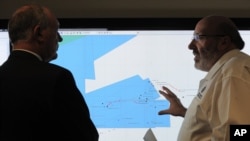U.S. law enforcement officials say investigators checking a home flight simulator and e-mails of the pilots of the missing Malaysian airliner have failed to find evidence that either pilot purposely steered the flight away from its destination.
The two U.S. law enforcement officials spoke Tuesday after being briefed by Malaysian authorities who are leading a 26-nation search for Malaysia Airlines Flight 370.
The airliner, which was bound for Beijing with 239 people aboard, vanished over southeast Asia March 8, triggering the largest missing airplane search in aviation history.
One of the U.S. officials said authorities were trying to learn whether pilot Zaharie Ahmad Shah might have been training on the simulator on how to disable transponders and other in-flight devices ahead of take-off from Kuala Lumpur. Investigators were also seeking to learn whether he had practiced flight patterns taking the plane away from its destination.
The official, quoted by the Los Angeles Times, also noted that the Malaysian co-pilot was making preparations for his wedding in his homeland.
Search continues
Meanwhile, the search for the missing Malaysia Airlines plane has expanded again and now covers more than 7 million square kilometers, extending from Central Asia in the north to the vast waters of the Indian Ocean to the south.
Thailand's military released new radar information Tuesday that could support earlier reports that the Malaysia Airlines jet made a sharp turn to the west toward the Strait of Malacca after its last contact was recorded early March 8 north of Malaysia.
Countries participating in the search effort - Infographic
The Thai government said its radar detected a plane that may have been the missing Flight 370, but initially paid little attention to the jet because it was not considered a security threat.
On Tuesday, Malaysia Defense Minister Hishammuddin Hussein called for more international cooperation in helping to narrow the search.
Authorities believe the Boeing 777 was deliberately diverted and flew either north toward Central Asia, or south toward the Indian Ocean.
More than 26 nations are involved in the effort to find the jet, which disappeared en route from Kuala Lumpur to Beijing.
Authorities are considering all possiblities when it comes to the fate of Flight 370 and the 237 people on board, including terrorism, hijacking or a mechanical malfunction.
China says no suspect passengers
Beijing said on Tuesday that none of the flight's 154 Chinese passengers appear to have links to terrorism.
China's ambassador to Malaysia said extensive background checks were completed on the passengers from the mainland.
"China has investigated the backgrounds of all Chinese passengers on board the missing Malaysia Airlines flight MH 370, and has found no evidence suggesting they are linked to destructive behavior on the aircraft," said Huang Huikang. "So we can rule out the suspicion that Chinese passengers are linked to a terror attack or destructive activities on the missing plane."
China said it has deployed 21 satellites to help in the effort to find the commercial airliner. The ambassador also said China has begun looking for the aircraft in the territory along the northern corridor of the search area.
In their quest to find more answers about what may have happened to the plane, investigators are looking into the backgrounds of all of those on board, including the flight's captain, co-pilot and crew. Authorities say that whoever took control of the plane had a deep knowledge of the jet and its systems.
Huang said experts and security officials from China have been helping out with the investigation since shortly after the plane vanished. However, what China's review of its radar data has uncovered remains unclear.
Publicly reviewing radar data has already proven to be a particularly touchy process because it can reveal a country's air defense capabilities.
Altered route
The New York Times reports the plane's intended route appears to have been altered by a computer system mostly likely programmed by someone in the cockpit with knowledge of advanced aircraft systems.
Speaking anonymously, U.S. officials told the Times the development reinforces the theory that foul play was involved and will likely increase scrutiny of the plane's pilot and co-pilot.
The search has been complicated because the plane's transponder, which identifies it to civilian radar, and other communications devices were disabled or shut off. Authorities are now forced to rely on imprecise satellite tracking data based on automated messages from the aircraft.
The search area is now so extensive that the U.S. on Monday called back the USS Kidd, a naval destroyer that had been looking for the plane in the Indian Ocean. U.S. officials say it makes more sense to look for the jet using long-range surveillance aircraft.
Some information in this report was contributed by VOA's William Ide in Beijing.
The two U.S. law enforcement officials spoke Tuesday after being briefed by Malaysian authorities who are leading a 26-nation search for Malaysia Airlines Flight 370.
The airliner, which was bound for Beijing with 239 people aboard, vanished over southeast Asia March 8, triggering the largest missing airplane search in aviation history.
One of the U.S. officials said authorities were trying to learn whether pilot Zaharie Ahmad Shah might have been training on the simulator on how to disable transponders and other in-flight devices ahead of take-off from Kuala Lumpur. Investigators were also seeking to learn whether he had practiced flight patterns taking the plane away from its destination.
The official, quoted by the Los Angeles Times, also noted that the Malaysian co-pilot was making preparations for his wedding in his homeland.
Search continues
Meanwhile, the search for the missing Malaysia Airlines plane has expanded again and now covers more than 7 million square kilometers, extending from Central Asia in the north to the vast waters of the Indian Ocean to the south.
Thailand's military released new radar information Tuesday that could support earlier reports that the Malaysia Airlines jet made a sharp turn to the west toward the Strait of Malacca after its last contact was recorded early March 8 north of Malaysia.
Countries participating in the search effort - Infographic
The Thai government said its radar detected a plane that may have been the missing Flight 370, but initially paid little attention to the jet because it was not considered a security threat.
On Tuesday, Malaysia Defense Minister Hishammuddin Hussein called for more international cooperation in helping to narrow the search.
Authorities believe the Boeing 777 was deliberately diverted and flew either north toward Central Asia, or south toward the Indian Ocean.
More than 26 nations are involved in the effort to find the jet, which disappeared en route from Kuala Lumpur to Beijing.
Authorities are considering all possiblities when it comes to the fate of Flight 370 and the 237 people on board, including terrorism, hijacking or a mechanical malfunction.
China says no suspect passengers
Beijing said on Tuesday that none of the flight's 154 Chinese passengers appear to have links to terrorism.
China's ambassador to Malaysia said extensive background checks were completed on the passengers from the mainland.
"China has investigated the backgrounds of all Chinese passengers on board the missing Malaysia Airlines flight MH 370, and has found no evidence suggesting they are linked to destructive behavior on the aircraft," said Huang Huikang. "So we can rule out the suspicion that Chinese passengers are linked to a terror attack or destructive activities on the missing plane."
Flight MH370 Timeline
Flight MH370 Timeline-
Mar. 8: Departs Kuala Lumpur at 12:41am local time for Beijing
Air traffic controllers lose contact with the plane around 1:30am
Vietnam launches search operation, two oil slicks are spotted but are not related to plane
-
Mar. 9: Malaysia suggests plane may have strayed off course
Debris spotted off Vietnam, but it is not from the airplane
-
Mar. 10: Search radius expanded, as China urges Malaysia to speed up investigation
-
Mar. 11: Search extended to western side of Malaysian peninsula
-
Mar. 12: Chinese satellite images of possible debris are released and determined not to be related to the plane
-
Mar. 13: Malaysia rejects Wall Street Journal report that MH370 flew for four hours after its last known contact
-
Mar. 14: Search now includes South China Sea, Malacca Strait and Indian Ocean
Media reports say MH370 communications system continued to ping a satellite hours after plane disappeared
-
Mar. 15: Malaysian Prime Minister Najib Razak says someone on MH370 likely turned off its communications systems
-
Mar. 17: 26 countries now involved in the search
-
Mar. 19: FBI analyzes flight simulator data from the home of the MH370 pilot
- Mar. 20: Australian aircraft investigate possible debris in a remote area of the southern Indian Ocean
In their quest to find more answers about what may have happened to the plane, investigators are looking into the backgrounds of all of those on board, including the flight's captain, co-pilot and crew. Authorities say that whoever took control of the plane had a deep knowledge of the jet and its systems.
Huang said experts and security officials from China have been helping out with the investigation since shortly after the plane vanished. However, what China's review of its radar data has uncovered remains unclear.
Publicly reviewing radar data has already proven to be a particularly touchy process because it can reveal a country's air defense capabilities.
Altered route
Aviation Mysteries
Aviation Mysteries- 1937: Amelia Earhart disappears during flight over Pacific, no trace of plane found
- 1996: TWA Flight 800, en route to Paris from New York, explodes over Long Island, questions remain over cause
- 1999: EgyptAir Flight 990 crashes into Atlantic while headed to Cairo from New York; US questions if pilot comments indicated suicide mission
- 2009: Air France Flight 447 goes down over Atlantic while traveling from Rio de Janeiro to Paris, crash report indicates pilot confusion
Speaking anonymously, U.S. officials told the Times the development reinforces the theory that foul play was involved and will likely increase scrutiny of the plane's pilot and co-pilot.
The search has been complicated because the plane's transponder, which identifies it to civilian radar, and other communications devices were disabled or shut off. Authorities are now forced to rely on imprecise satellite tracking data based on automated messages from the aircraft.
The search area is now so extensive that the U.S. on Monday called back the USS Kidd, a naval destroyer that had been looking for the plane in the Indian Ocean. U.S. officials say it makes more sense to look for the jet using long-range surveillance aircraft.
Some information in this report was contributed by VOA's William Ide in Beijing.










